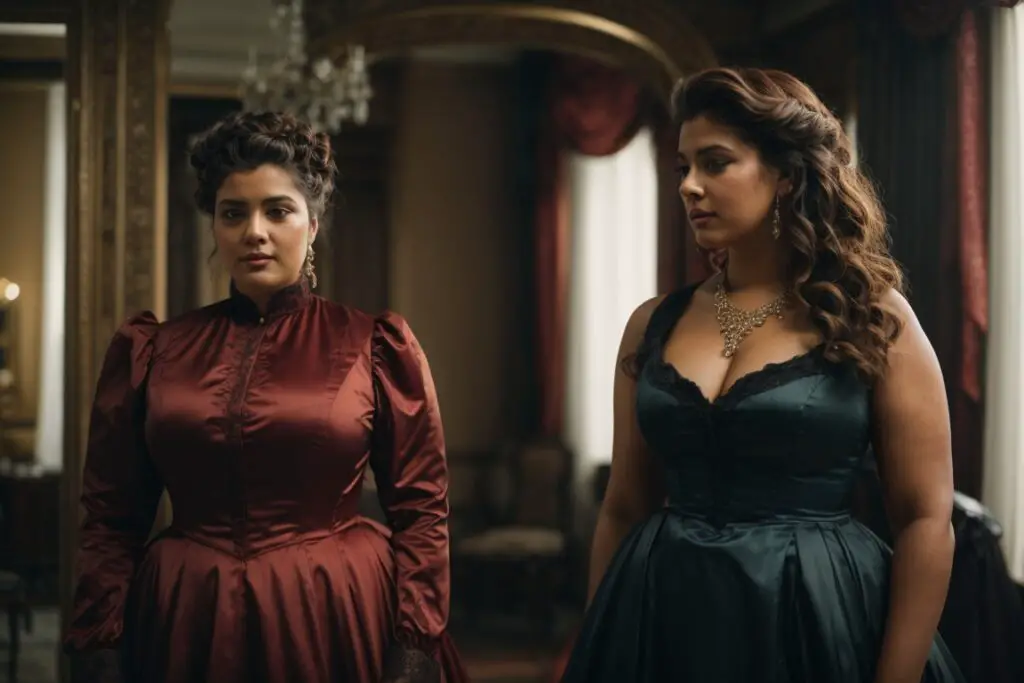It’s a dilemma every woman has faced at least once. You find a great piece of clothing and then begin frantically flipping through the rack, hoping it’s available in your size. Yet sometimes, you feel like you don’t know what your size is. Are you plus-size or regular size? When do plus sizes start?
Although plus sizes tend to start at size 14, it really depends on the retailer. For some brands, you’re plus-size if you’re a size 8 or 10, while for others, clothing sizes 12 and up are plus-size.
Yes, it isn’t obvious, as we’re sure you’d expect it to be. We’re here to help you navigate the world of women’s clothing sizing so you can find clothes that are complementary to your shape rather than embarrassingly tight or potato sack-loose.
Let’s get started!
Understanding Plus-sizes and When They Start
In women’s fashion, there are what they call straight sizes and then curvy sizes. Straight sizes are any clothing for smaller women, whereas curvy sizes can also be referred to as plus sizes. Yet when straight sizes end and sizes begin is anyone’s guess.
If you remember our article on plus-size models, we discussed how the modeling industry labels women plus-size if they’re a size 8. Yet, depending on your proportions, you can also be considered plus-size as a model even if you’re a size 0. Bustier models or those with wider hips might earn this unique distinction.
That warps what is already a very fuzzy label on plus-size clothing. Although they go hand in hand, the fashion industry and modeling industry diverge on size 8 being plus size. In just about any store, if you’re a size 8, you’re still considered a straight size. You’re on the cusp of not being a straight size, but you’re a straight size nonetheless.
Okay, so plus size isn’t size 8, so when does it begin?
Plus Model Magazine is once quoted as stating that: “In the fashion industry, plus size is identified as sizes 18 and over, or sizes 1X-6X and extended size as 7X and up.”
Whoa! Although being size 18 is definitely plus size, that’s generally not where the plus-size bar starts. If anything, that’s size 14, although it can sometimes be size 12 and some retailers, even size 10.
We told you it was confusing!
To help you make more sense of things, we combed the Internet for popular straight-size shops and some plus-size offerings to determine at which size their plus clothing begins. Here’s the lowdown:
- Prettylittlething: Size 12
- ASOS: Size 12
- Nasty Gal: Size 12
- Lane Bryant: Size 10
- Ashley Stewart: Size 10
As you can see, it’s typical for straight sizes to use size 12 as the start of plus-size clothing and for plus-size retailers to refer to clothes in sizes 10 and up as plus-size.
Is Size 10 Plus-Size?
Yet if you’re a size 10, are you truly plus size? Clearly, yes, you are to some retailers, but to many more, you aren’t. If anything, you’re what’s known as an in-between size or an in-betweener.
This 2019 article from The Everygirl explains the dilemma of being an in-betweener perfectly. If you try to shop at a straight-size retailer such as Forever 21, women who need clothes in a bigger size than a large can rarely find them. Yes, Forever 21 carries XL clothing, which is still considered straight-size, but some garments only go up to an L.
These women won’t fit in a large, but plus-size 0X size–which is the smallest plus size Forever 21 carries–is too big for them. The Everygirl article mentions that finding a size 0X garment or any piece of plus-size clothing in a physical Forever 21 store is like recovering a needle from a haystack. In other words, good luck.
We’re not singling out Forever 21 at all; please don’t think that. They’re one store of many that create this problem for in-betweeners at a size 10.
So what does an in-betweener at size 10 do when she can’t fit into straight sizes at a store, but the plus sizes are too big? Well, the answer is easy: stop shopping at that store. Yet, she will run into the same issue at many of the other most popular retailers that carry primarily straight sizes, as their sizing isn’t all that different.
Vox published an article on the same topic. They talk about how plus-size models such as Ashley Graham have helped plus sizes gain more acceptance in popular culture, yet the real women of that same size don’t have the same luxury that Graham does. They can’t find chic, cute clothes in their size as she can.
This is sometimes by design, as Vox mentions. They talk about a case in 2013 at a Philadelphia Lululemon that was investigated and then written about by the Huffington Post. The Philly store had plus-size Lululemon garments, but they were hidden–quite literally, in this case–as the clothes were bunched and stuffed beneath a table.
Beyond that, the plus-size clothes on the rack were segregated to a different part of the store than the rest of the clothes and weren’t restocked nearly as often.
Granted, this isn’t only a struggle for women who are plus size or on the cusp like a size 10. Vox quoted a former Racked editor who had difficulty finding clothing in New York in size 8. Yes, a size 8, which we’ve already established, is not plus-size.
Speaking of Racked, they’re the same site that brought to light the fact that, as of 2018, 68 percent of women in the United States are at least a size 14. Yes, we cite that stat a lot, but only because it’s so pertinent.
At 68 percent, plus-size women are the majority. If you owned a restaurant and most of your customers had a nut allergy, would you keep a nut-filled brownie on the menu? No! Yet, in fashion, most women continue to be ignored because of warped and out-of-date beauty ideals.
How Do You Figure Out If You’re Plus-Size?
All this talk about sizing makes you wonder if you’re a straight size or curvy. As we’ve always proven, going by retail sizing is about the worst way to find out. Each store has its own standards for sizing, and so your size will be inconsistent from store to store.
For more accurate results, measure yourself, including your breasts, your hips, and your waist. There’s no need to go to a professional for measuring unless you want to. You can easily measure yourself at home with a flexible measuring tape. It helps if you have someone you can trust to hold the tape or write down the numbers.
To measure your waist, put the measuring tape around your natural waist. This is the part of your waist that creases first when you lean from one side to another. It’s often the narrowest point of a woman’s waist, but not exclusively.
You need to find the part of your breasts that are fullest to record your bust. For lots of women, this is the area where their nipples are.
Hip measurements involve wrapping the measuring tape around your hip bone and recording that number. Some stores will list hip size by low hip, which is not the same as a standard hip measurement.
We’ve discussed this on the blog before, but it seems like a good time to bring it up again. Your lower hips are the fullest area of your hips, with your rear included.
If it’s your lower hips or your regular hips that you’re measuring, make sure you’re standing up straight and keep your feet together but in a natural way.
With those measurements, you’re ready to go shopping. Whether you plan to visit a store in-person or do your shopping online, please pull up the store’s size chart before adding anything to your cart.
Knowing your measurements can make shopping 20 times easier, even if you’re an in-betweener or a plus-size gal. To show you how, let’s look at the sizing charts for four different stores, some plus-size and others straight-size. They are Prettylittlething, Ashley Stewart, Wet Seal, and Lane Bryant.
Let’s say you have a bust size of about 40 inches, a hip size of around 41 inches, and a waist size of around 32 inches.
At Ashley Stewart, the closest size that correlates to your measurements is an XL for 31.5-inch waists, 40-inch busts, and 41.5-inch hips. You’re a size 12 in their book.
Based on Prettylittlething’s size chart, if your bust is 40.5 inches, your waist 33.5 inches, and your hips are 43.75 inches, you’re a plus-size medium in their sizes, which correlates to a size 12. Yes, there is such a thing as a plus-size medium at Prettylittlething.
Over at Lane Bryant, a woman with a 40-inch bust, 34-inch waist, and 42.5-inch low hips is a size 12. You’re also a size 12 at Wet Seal if your bust is 39 inches, your waist 32 inches, and your hips 41 inches.
Is it always as cut and dried as that? No. Once you get into larger plus sizes, you notice slight size discrepancies. For example, maybe you’re a size 16 at Ashley Stewart but a size 18 at Lane Bryant or vice-versa. That’s why it’s always best to rely on the measurements rather than some arbitrary size number!
Conclusion
When plus sizes start could be anywhere from a size 8 to a 14 depending on which store you visit and who you ask. The plus-size modeling industry has made matters convoluted, but no more does that onus fall on various straight-size and even plus-size retailers who all have their own rules on who fits in what.
Measuring yourself remains the most reliable means of finding clothes that fit you. That’s the case for straight-size women, in-betweeners, and plus-size ladies alike. The latter two groups have a much harder time finding bigger clothes as it is. Don’t make things harder by purchasing plus clothes that don’t even fit!
Keep in mind whenever you shop, that size is truly, truly just a number and not worth stressing about. Whatever size you are in one store, you could be a completely different size in another.



